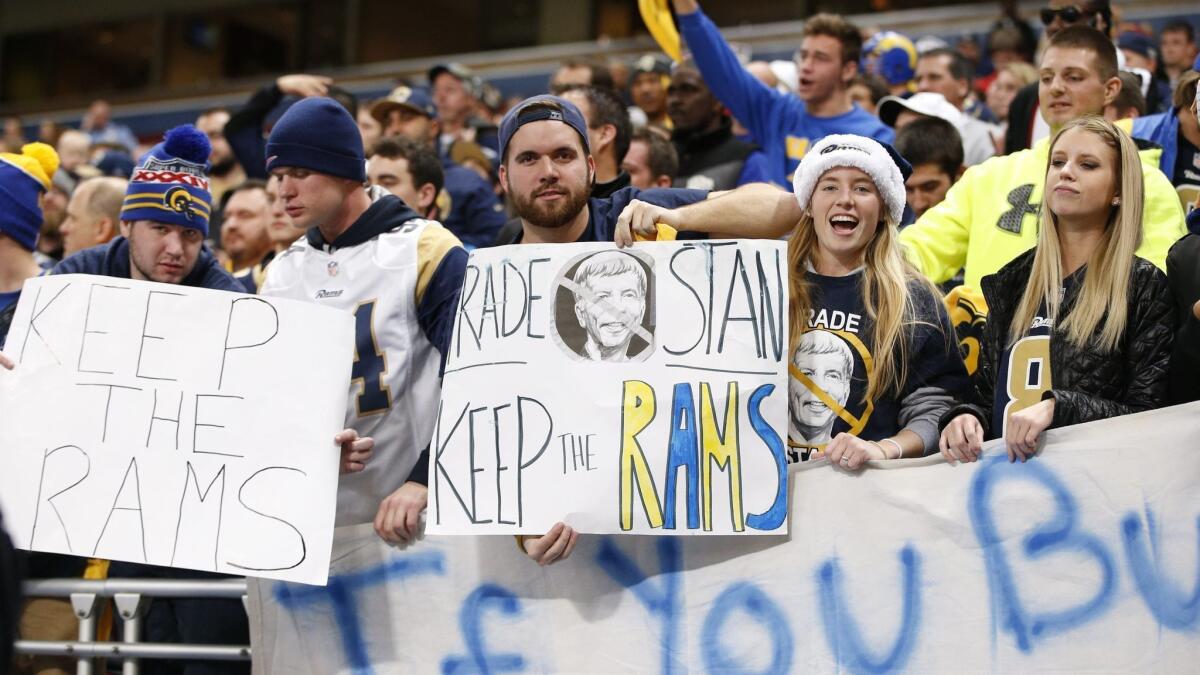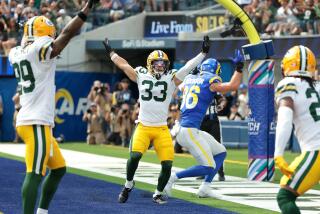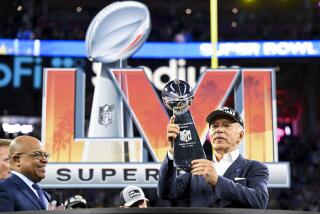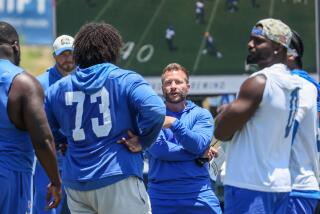Rams might be America’s team outside Boston, but not in St. Louis
Reporting from St. Louis — The pixelated billboard outside the Dome at America’s Center offered no acknowledgment of its previous tenant.
Two days after the Rams clinched their first Super Bowl berth since 2002, the building — which in its heyday housed “The Greatest Show on Turf” — offered no evidence of celebrating the achievement.
“Welcome to St. Louis,” the screen read, before pivoting to an advertisement for a Garth Brooks concert in March.
Three years after the Rams uprooted for Los Angeles, three years after Stan Kroenke became an epithet in this town, three years after a twister of hurt feelings and litigation was kicked up, the outbursts of rage have morphed into pangs of melancholy.
Former Rams fans harbor more emptiness than anger. They hide the hurt well. In order to find remnants of their fandom, you have to search a little deeper than the stadium situated a few blocks from the Mississippi River.
On a rainy Tuesday evening, inside a shopping center about 30 miles west of downtown, a man named Matt Meier led the way to a hidden stockpile inside the Rally House sporting goods store he manages in St. Peters, Mo.
Meier strode past displays for baseball’s Cardinals, hockey’s Blues, the Missouri Tigers and Kansas City Chiefs. He veered away from the sections for Missouri State and Saint Louis University.
Finally, he opened the door to a back-room warehouse overflowing with discounted “Millennium Blue and New Century Gold”-colored Rams gear.
“Believe it or not,” Meier said, “there are still some Rams fans here.”
After the team left in January of 2016, Rally House decided to consolidate the Rams gear from its five stores into one location, across the hall from the men’s room. The stash stretches on hangers spread across one wall, with five separate racks nearby, a collection of T-shirts, polos and hoodies. There are fitted caps, snapbacks and dad hats. In boxes across the room is even more Rams-stamped ephemera: piggy banks, alarm clocks, golf balls, sandals, slippers, cell-phone cases and $17.99 thongs.
During the season, Meier estimated, the store receives a couple of customers a week in search of Rams apparel. There are also a few knowledgeable shoppers who make repeated visits. But there is far more interest these days in the cross-state Chiefs, whose merchandise is positioned in the front display window. When Kansas City lost to New England in the AFC championship game Jan. 20, a nightmare scenario unfolded for St. Louis, with bitter memories raised by both Super Bowl participants.
By that Sunday evening, when the Super Bowl matchup finally was set, “St. Louis was in a collective depression,” said Bob Wallace, a former Rams executive who is now an attorney in the city. Wallace cited the Spygate allegations that dogged the Patriots after they beat the St. Louis Rams in Super Bowl XXXVI in 2002.
“The Patriots were probably the city’s least favorite team, prior to the Rams leaving,” Wallace said. “The Rams are now the least favorite team.”
One night last week, former season-ticket holders Rick and Ronda Freedman gathered a collection of heirlooms on their kitchen table. There was a baseball cap given out to the original class of personal-seat license holders from 1995. There was a photograph of star cornerback Aeneas Williams visiting a school. There were a trio of tickets to playoff games from the 1999 season, when Kurt Warner, Marshall Faulk and Isaac Bruce formed a revolutionary offense.
The paraphernalia gather dust these days. Ronda joked that Rick wanted to torch it all, but she couldn’t go through with it.
“A lot of people in St. Louis just enjoy seeing the Rams lose, at this point,” Rick said. “Because they burned the city of St. Louis.”
Said Ronda: “It’s all the ownership. Nobody dislikes the players.”

The Rams do not inspire simple antipathy here. Their former fans root for the kicking duo of Johnny Hekker and Greg Zuerlein. They admire the prowess of defensive tackle Aaron Donald and running back Todd Gurley. They feel jealousy about the partnership between coach Sean McVay and quarterback Jared Goff.
The majority of the anger is directed toward the management team of Kroenke and chief operating officer Kevin Demoff. Local members of the media accuse the pair of conspiring to leave without giving the city a fair chance to keep the team. They blame the NFL for facilitating the move. And they curse Kroenke for denigrating the market on his way out by saying it could not support pro football.
“In St. Louis history, sports or otherwise, the two most reviled people are Stan Kroenke and Kevin Demoff,” said Randy Karraker, who hosts the afternoon drive-time show on 101 ESPN. “They are met with disdain every time their name comes up.”
Kroenke could not be reached for a response. A representative for Kroenke Sports and Entertainment directed all questions to the Rams. A spokesperson for the team said the Rams would not comment.
Kroenke was instrumental in delivering the Rams to St. Louis in the first place. He bought a 40% stake in the team when Georgia Frontiere moved the Rams out of Los Angeles in 1995. In their fifth season in town, lightning struck. Warner went from grocery bagger to Super Bowl MVP. The team made the playoffs five times during a six-year stretch, and the Rams superseded the Cardinals as the city’s hottest ticket.
“The team was so incredibly popular,” said Tiffani Wilson Burris, who worked for the Rams for several years before becoming the executive director of the Isaac Bruce Foundation. “They were so beloved in this city. People loved them. It was everything.”
Williams played the final four seasons of his Hall of Fame defensive back career in St. Louis before becoming a pastor in a suburb outside the city. Fifteen years after he made his final tackle, he still receives reminders from members of the community. He said he will be greeted by “three generations of fans — grandfather, father and son,” who tell him stories about games inside the dome. “Fond memories,” he said, “that people will remember for the rest of their lives.”
The downturn began in 2005. Coach Mike Martz stepped down because of a heart issue midway through a 6-10 season, which ushered in a decade of losing. The team went 50-109-1 from 2006 to 2015 under the coaching guidance of mediocrities such as Scott Linehan, Steve Spagnuolo and Jeff Fisher. The front office misfired in the draft. Attendance continued to sag after Kroenke became the primary owner in 2010. As the team stalled, the rumblings about Los Angeles intensified when Kroenke purchased 60 acres of land in Inglewood in 2014.
“You start hearing the rumors that the team was looking to leave, and then people get angry and they stop going to games,” Burris said. “That hurt St. Louis’ chances of keeping the team, because your attendance is down.
“But you can’t really blame anyone at that point because they know the team is trying to leave, so they don’t want to give them the money. It was really hard to watch it just fade away, when there was such magic at one time.”
St. Louis had already lost pro football once. That team, also the Cardinals, left for Phoenix in 1988. But locals sought to make a distinction between that move and the departure of the Rams. Back then, Karraker and Wallace explained, the city allowed the team to go without much effort.
In the more recent case, Missouri Gov. Jay Nixon in 2014 assembled a task force, headed by attorney Bob Blitz and former Anheuser-Busch executive Dave Peacock, to entice the Rams to stay. In January 2015, Kroenke revealed plans to build a stadium at the Inglewood site. The task force could not convince him there was a more suitable alternative in St. Louis.
Blitz is now leading one of four lawsuits filed in the wake of the Rams’ exit. The team recently reached a settlement regarding the thousands of fans who bought personal-seat licenses. There remains litigation regarding the ownership of the team’s former practice facility and a suit involving merchandise. Blitz is involved in a suit filed on behalf of the city and the county alleging breach of contract and fraud, among other charges, related to the team relocating.
A message left for Peacock went unreturned. A representative from the St. Louis Sports Commission declined to comment. An email sent to Blitz met a similar fate. “Thanks for thinking of us but it is our policy not to comment on pending litigation,” Blitz replied.
As the lawsuits wended their way through the legal system, the city attempted to move forward. The jilted fans took glee in the Rams’ 4-12 campaign in 2016, the first season in Los Angeles. A local Dairy Queen offered discounted ice cream after every loss. A chain of bars put Kroenke’s face on the urinal cakes. Individual donations to Bruce’s foundation shrank, as fans didn’t want to associate with the brand, Burris said.
“It’s hard because people are so hurt right now,” Burris said. “Maybe, eventually, that hurt will fade a little bit. But right now, it’s just so new, and it hurt so bad for so many of these fans.”
Sign up for our daily sports newsletter »
With the arrival of McVay as coach, schadenfreude became more difficult. No longer were the Rams a laughing stock. Ambivalence became more prevalent. The Freedmans shifted their devotion toward Ohio State, where their son went to college. “I’m amazed by the number of people who reached out to me on social media over the weekend and said they’re just completely done with the NFL,” Karraker said.
The vacuum has not yet been filled. At OB Clark’s sports bar in nearby Brentwood, Mo., the ceiling was adorned with strands of red, blue and green lights. A Missouri helmet rested atop the bar; a Cardinals baseball-themed Budweiser sign glowed red. The bartender wore a New Orleans Saints T-shirt while vouching for the day’s special, the pan-fried chicken for $8.95.
A fellow wearing a Rams cap finished his meal and walked toward the door.
“There’s a young man who is rooting for the Rams,” cracked Jim O’Brien, who has co-owned and operated the bar with his brother Joe for three decades. The bar used to be a regular landing spot for Rams officials, he said. They would receive occasional visits from Hekker and Zuerlein, Sam Bradford and Chris Long.
During the NFC championship game on Jan. 20, O’Brien estimated, about 70% of bar patrons was rooting for the Saints. He couldn’t blame them. He watched how the team wilted during its final years in St. Louis, only to blossom in Los Angeles. “I don’t really think they’re rooting against the Rams as much as they’re rooting against the Rams’ owner,” O’Brien said.
Along the walls, the bar used to hang framed jerseys of Bradford and Warner. Now the walls featured the jersey of baseball all-star Matt Carpenter from the Cardinals and four hockey players. O’Brien was asked what became of the Rams gear. Did he trash it?
“Oh, no, I wouldn’t throw it out,” O’Brien said. “We’re not that angry. We still like those guys.”
Instead, they packed away the gear in the basement. Like the rest of the Rams’ legacy in this city, it’s hidden but not forgotten.
Twitter: @McCulloughTimes
More to Read
Go beyond the scoreboard
Get the latest on L.A.'s teams in the daily Sports Report newsletter.
You may occasionally receive promotional content from the Los Angeles Times.











